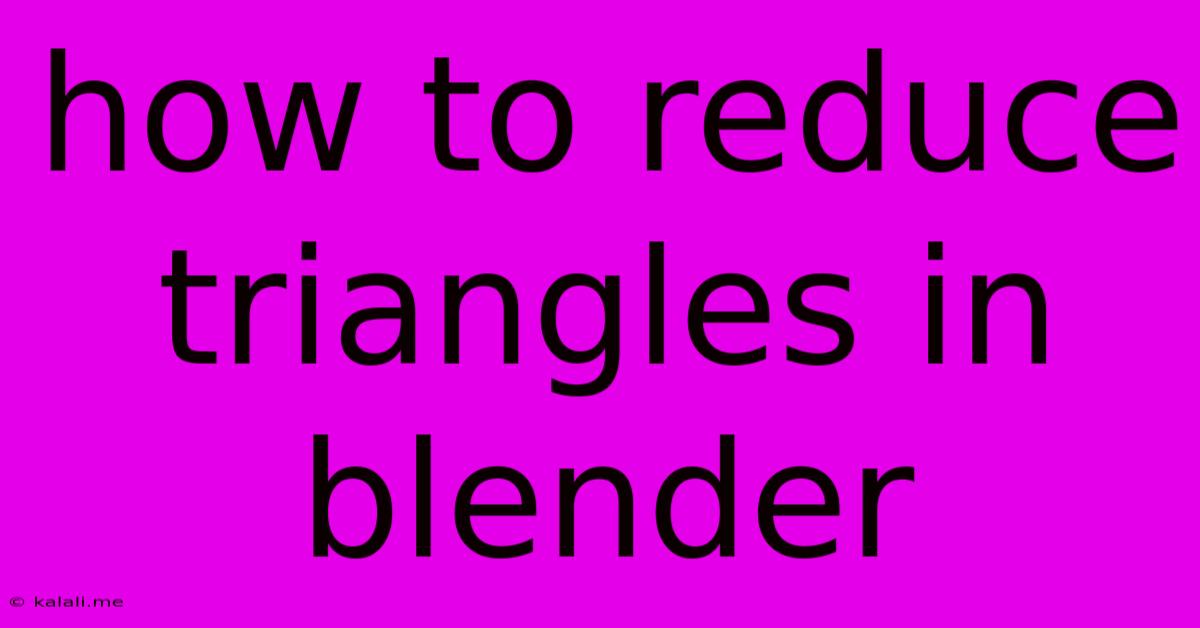How To Reduce Triangles In Blender
Kalali
May 26, 2025 · 3 min read

Table of Contents
How to Reduce Triangles in Blender: Optimizing Your 3D Models for Performance
Reducing the polygon count (number of triangles) in your Blender models is crucial for improving rendering performance, especially when working with complex scenes or lower-end hardware. A high triangle count leads to longer render times and can cause lag during modeling and animation. This guide outlines effective strategies to reduce triangles in Blender without significantly impacting visual quality. Learn how to optimize your models for smoother workflows and faster renders.
Why Reduce Triangles?
Before diving into the techniques, understanding the why is essential. High-poly models, while visually detailed, demand significantly more processing power. This translates to:
- Slower rendering: More triangles mean more calculations for the render engine.
- Laggy viewport: Navigating and manipulating high-poly models in the Blender viewport can be sluggish.
- Larger file sizes: High-poly models consume more disk space.
- Reduced compatibility: Some game engines and platforms have limitations on polygon counts.
Methods to Reduce Triangles in Blender:
Here's a breakdown of effective methods to decrease your triangle count while maintaining visual fidelity:
1. Decimation Modifier: A Quick and Easy Approach
The Decimation Modifier is a powerful tool for quick polygon reduction. It offers several algorithms, each with its strengths:
- Planar: Reduces triangles based on planarity, ideal for flat surfaces.
- Collapse: Collapses edges, suitable for overall polygon reduction.
- UnSubdivide: Reverses subdivision surface operations, useful for models created using subdivision modeling techniques.
How to use it:
- Add the Decimation Modifier to your object.
- Adjust the "Ratio" slider to control the level of decimation. A lower ratio means more polygons are retained. Experiment to find the optimal balance between polygon count and detail.
- Use the "Preview" option to visualize the changes in real-time.
Pro-Tip: Use the "Keep Boundaries" option to preserve the sharp edges of your model.
2. Retopology: Creating a Clean Low-Poly Mesh
Retopology involves creating a new, simplified mesh that closely follows the shape of your high-poly model. This is a more involved process but offers greater control over the final result and typically achieves better results in terms of maintaining detail.
Process:
- Prepare your high-poly model: Ensure it's clean and well-defined.
- Create a new mesh: Start with a simple base mesh (like a cube or sphere) and manually sculpt or use retopology tools to recreate the shape of the high-poly model.
- Use retopology tools: Blender offers several tools to streamline this process, including the "Knife Project" tool.
- Adjust the density: Focus on placing polygons where detail is most important.
3. Subdivision Surface Modifier: Smart Polygon Reduction
The Subdivision Surface Modifier is often used to create smooth surfaces from low-poly meshes. It's also useful in reverse: start with a high-poly model, apply the modifier, then decimate it.
How to use it:
- Add the Subdivision Surface Modifier.
- Adjust the "Levels" value for the desired smoothness.
- Apply the modifier to create a new high-poly mesh.
- Use other methods like the Decimation Modifier to reduce the polygon count.
4. Optimize Your Modeling Workflow
Preventing excessive triangles from the start is the most effective strategy.
- Use fewer polygons in initial modeling: Avoid unnecessary subdivisions.
- Use efficient modeling techniques: Learn to use edge loops and other efficient modeling practices to create clean and optimized meshes from the beginning.
- Boolean operations carefully: Overuse of Boolean operations can create unnecessarily complex geometry.
5. Consider Using Proxies and Level of Detail (LOD)
For complex scenes, consider using proxies (lower-poly versions of your models) for previewing and pre-visualization. LOD systems are also very beneficial, allowing you to swap in different levels of detail based on the camera distance.
Conclusion:
Reducing triangles in Blender is essential for optimizing your workflow and render times. By combining these techniques, you can achieve a significant reduction in polygon count while maintaining visual quality. Experiment with these methods to find the best approach for your specific models and projects. Remember, the key is finding the balance between visual fidelity and performance.
Latest Posts
Latest Posts
-
Flowchart For Basic Solar Backup System With Electric Co Power
May 26, 2025
-
The Best Is The Enemy Of The Good
May 26, 2025
-
How To Remove Wax From Clothing
May 26, 2025
-
Vscode Terminal Send Sequence Delete All Left Cursor Sendsequence
May 26, 2025
-
How To Fill Gaps In Wood Floors
May 26, 2025
Related Post
Thank you for visiting our website which covers about How To Reduce Triangles In Blender . We hope the information provided has been useful to you. Feel free to contact us if you have any questions or need further assistance. See you next time and don't miss to bookmark.